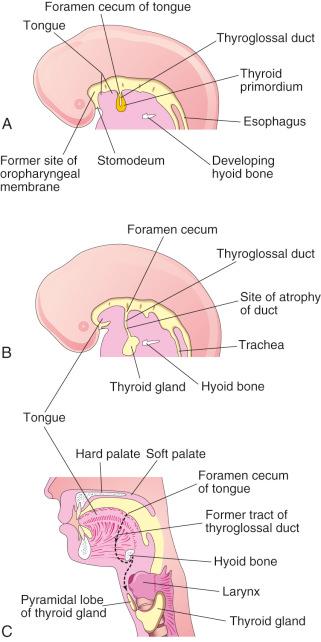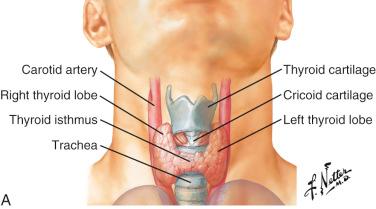Physical Address
304 North Cardinal St.
Dorchester Center, MA 02124
Thyroid gland is the first endocrine gland to appear during embryonic development.
Thyroid gland derives from three primordium, median anlage, and lateral anlagen:
Median anlage develops around the twenty-fourth day of gestation as a small, median endodermal thickening on primitive pharynx.
This thickening forms a diverticulum, which attaches to tongue by a narrow tube referred to as thyroglossal duct.
Opening in base of tongue constitutes foramen cecum
Lateral anlagen correspond to ultimobranchial body, which derives from pharyngeal pouches:
Ultimobranchial body from which C-cells originate fuses and incorporates into thyroid gland.
As result of further cellular proliferations, hollow thyroid diverticulum obliterates and divides into right and left lobes, connected by isthmus around seventh week of gestation.
During development thyroid descends and assumes a definitive position in anterior neck, at which time:
Thyroglossal duct undergoes atrophy
In approximately 40% to 50% of individuals, inferior end of thyroglossal duct persists as pyramidal lobe, which is attached to hyoid bone by fibrous or muscular tissue.
Faulty migration (of medial anlage) or persistence of thyroglossal duct may give rise to thyroid ectopia (e.g., lingual thyroid, other) or thyroglossal duct cysts.
Proximal opening persists as foramen cecum of tongue.
Development of thyroid gland controlled by coordinated action of specific transcription factors, including:
Thyroid transcription factor 1 (TTF-1), TTF-2, paired box gene 8 (PAX8), and hematopoietically expressed homeobox (HHEX)
Altered expression of transcription factors play a role in thyroid dysgenesis.
Thyroid follicular cells:
Endodermal cell mass constituting thyroid primordium is separated into cords by invasion of vascular mesenchyme and divide into smaller groups around tenth week of gestation.
A single layer of cells becomes arranged around a lumen, and primitive follicles make their appearance around the eleventh week of gestation.
At the time colloid is stored, iodine concentrates and hormone synthesis can be demonstrated.
By week 14, follicles with central lumen containing colloid are well developed.
Follicular cells and colloid are thyroglobulin positive.
Thyroid C-cells:
Neuroendocrine cells presumed to be of neural crest derivation
Originate from ultimobranchial body that migrates into pharyngeal pouches from branchial arches:
Reach thyroid via ultimobranchial body, which originates from fourth and fifth branchial pouch complex
While still attached to pharynx, ultimobranchial bodies start migration downward on each side of neck together with parathyroid fourth anlage.
At 7 to 8 weeks, ultimobranchial bodies separate from pharynx and parathyroids.
At weeks 8 to 9 appear as solid masses fusing with dorsolateral aspects of median thyroid anlage incorporated into developing lateral thyroid lobes
C-cells are largely restricted to middle and upper thirds of lateral thyroid lobes.
C-cells produce calcitonin, which regulates normal calcium levels in body.
Solid cell nests are believed to be remnants of ultimobranchial body

Thyroid gland is a reddish tan organ located in lower part of the neck on either side of the larynx and trachea placed anteriorly at level of fifth cervical to first thoracic vertebrae.
Thyroid gland is ensheathed by pretracheal layer of deep cervical fascia consisting of right and left lobes connected by a narrow median band of tissue referred to as the isthmus, which overlies the three tracheal rings below cricoid cartilage.
Weight of thyroid gland varies from 15 to 25 g in adults, is heavier in women than in men, and varies during pregnancy, iodine intake, and other pathologic conditions.
Lateral thyroid lobes have a conical shape, measuring 5 cm long, 3 cm transversally, and 2 cm anteroposteriorly:
Their ascending apices diverge laterally to level of oblique lines on laminae of thyroid cartilage, and their bases are level with fourth and fifth tracheal rings.
Each lobe, in posteromedial aspect, is attached to side of cricoid cartilage by a lateral thyroid ligament.
Isthmus connects both lobes, measures 1.25 cm transversely and vertically, and extends anterior to the second and third tracheal rings.
Pyramidal thyroid lobe:
Present in approximately 40% to 50% of the population
Conical shaped, projecting upwards from isthmus ascending to hyoid bone
Appears generally as a fibrous tract, but in pathologic conditions becomes prominent or cystic
Thyroid gland capsule:
Thyroid gland invested by thin connective tissue capsule firmly attached to gland
Numerous fibrous septa penetrate thyroid parenchyma, dividing gland into lobules.
Although gland grossly may appear completely encapsulated, microscopically capsule is incomplete in majority of population.
Surfaces and relations:
Convex lateral (superficial) surface of thyroid gland is covered by sternothyroid muscle.
Medial surface is adapted to larynx and trachea.
Superior pole contacts inferior pharyngeal constrictor and posterior part of cricothyroid, which separate it from posterior part of thyroid lamina and side of cricoid cartilage.
Inferiorly, trachea and more posteriorly recurrent laryngeal nerve (running in the tracheoesophageal space) and esophagus (closer on the left side) are medial relations.
Posterolateral surface of thyroid gland is close to carotid sheath and overlaps common carotid artery.
Anterior border is thin and near anterior branch of superior thyroid artery it slants down medially.
Rounded posterior border is related inferiorly to inferior thyroid artery and its anastomosis with posterior branch of superior thyroid artery.
On left side, lower end of posterior border of thyroid lies near thoracic duct.
Parathyroid glands are usually related to posterior border.
Isthmus is covered by sternothyroid muscle from which it is separated by pretracheal fascia; more superficially isthmus is covered by sternohyoid muscle, anterior jugular veins, fascia, and skin.

Become a Clinical Tree membership for Full access and enjoy Unlimited articles
If you are a member. Log in here